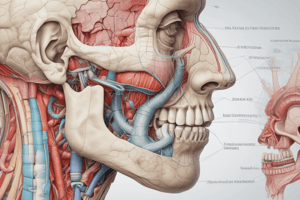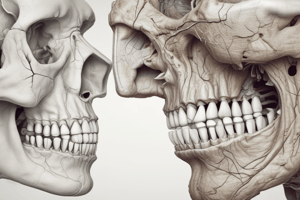Podcast
Questions and Answers
What structures divide the external nose into right and left halves?
What structures divide the external nose into right and left halves?
- Frontal processes of the maxillae
- Nasal bones
- Nasal septum (correct)
- Ala nasi
Which part of the nasal cavity is connected to the anterior cranial fossa?
Which part of the nasal cavity is connected to the anterior cranial fossa?
- Nasopharynx
- Little’s area
- Cribriform plate of ethmoid (correct)
- Ethmoid sinuses
Which bones form the roof of the nasal cavity?
Which bones form the roof of the nasal cavity?
- Nasal bones and frontal processes of the maxillae
- Sphenoid and frontal bones (correct)
- Ethmoid and sphenoid
- Maxilla and ethmoid
Infections from the nose can potentially spread to which region through the Eustachian tube?
Infections from the nose can potentially spread to which region through the Eustachian tube?
What supplies venous drainage to the nasal cavity?
What supplies venous drainage to the nasal cavity?
Which artery contributes to Little’s area in the nasal septum?
Which artery contributes to Little’s area in the nasal septum?
Which nerve supplies the lateral wall of the nasal cavity?
Which nerve supplies the lateral wall of the nasal cavity?
Which sinus opens into the superior meatus of the nose?
Which sinus opens into the superior meatus of the nose?
What is the function of paranasal sinuses?
What is the function of paranasal sinuses?
Which nerve supplies sensory innervation to the nasal cavity?
Which nerve supplies sensory innervation to the nasal cavity?
Which of the following bones contributes to forming the floor of the nasal cavity?
Which of the following bones contributes to forming the floor of the nasal cavity?
Through which structure do paranasal sinuses open into the lateral walls of the nasal cavity?
Through which structure do paranasal sinuses open into the lateral walls of the nasal cavity?
What is the specific function of the nasal septum?
What is the specific function of the nasal septum?
Which artery forms Little's area on the nasal septum?
Which artery forms Little's area on the nasal septum?
What is the nerve supply responsible for special sensation (smell) in the nasal cavity?
What is the nerve supply responsible for special sensation (smell) in the nasal cavity?
Which nerve provides autonomic parasympathetic supply to restrain nasal secretion?
Which nerve provides autonomic parasympathetic supply to restrain nasal secretion?
Where are the paranasal sinuses located in the skull?
Where are the paranasal sinuses located in the skull?
What is the function of paranasal sinuses in addition to secreting mucus and acting as resonators?
What is the function of paranasal sinuses in addition to secreting mucus and acting as resonators?
Flashcards are hidden until you start studying
Study Notes
Maxillary Sinus
- Located within the body of the maxilla behind the skin of the cheek
- Pyramidal in shape
- Opens into the middle meatus of the nose through the hiatus semilunaris
Frontal Sinus
- Two frontal sinuses contained within the frontal bone
- Separated from each other by a bony septum
- Each sinus is roughly triangular
- Opens into the middle meatus of the nose through the infundibulum
Ethmoid Sinuses
- Anterior, middle, and posterior sinuses contained within the ethmoid bone
- Located between the nose and the orbit
- Anterior sinuses open into the middle meatus through hiatus semilunaris
- Middle sinuses open into bulla ethmoidalis in the middle meatus
- Posterior sinuses open into the superior meatus
Nasal Cavity
- Connected to the anterior cranial fossa above (cribriform plate of ethmoid)
- Connected to the nasopharynx posteriorly (which is in communication with the middle ear cavity via the Eustachian tube)
- Connected to the paranasal sinuses which open into its lateral walls
- Infections can spread from the nose to these areas
Applied Anatomy
- Nasal cavity connected to areas above, posteriorly, and laterally
- Infections can spread to these areas
Epistaxis
- Common site of epistaxis is Little's area
- Located in the lower part of the nasal septum
- Anastomosis between branches of facial and sphenopalatine arteries
- Augmented by anterior ethmoidal artery
Blood Supply
- Anterior ethmoidal artery
- Long sphenopalatine artery
- Septal branch of superior labial branch of facial artery
- Anastomosis forming Kiesselbach's plexus
Nerve Supply
- Special sensation (smell) via olfactory mucous membrane and olfactory nerves (1st cranial nerve)
- General sensation (pain, feel, and temperature) via branches from trigeminal nerve (5th cranial nerve)
- Autonomic:
- Parasympathetic: supply nasal glands and restrain nasal secretion via vagus nerve (10th cranial nerve)
- Sympathetic: vasoconstriction via superior cervical ganglion
Paranasal Sinuses
- Cavities found in the interior of the maxilla, frontal, sphenoid, and ethmoid bones
- Lined with mucoperiosteum and filled with air
- Communicate with the nasal cavity through relatively small apertures
- Functions:
- Secrete mucous to keep nasal cavity moist and clean
- Reduce the weight of the skull
- Act as resonators to the voice
- Act as a shock absorber
Sphenoidal Sinuses
- Two sphenoidal sinuses lie within the body of the sphenoid bone
- Each sinus opens into the sphenoethmoidal recess above the superior concha
Nasal Cavity Boundaries
- Extends from the nostrils in front to the posterior nasal apertures behind
- Divided into right and left halves by the nasal septum
- Each half has:
- Floor
- Roof
- Lateral wall
- Medial or septal wall
Studying That Suits You
Use AI to generate personalized quizzes and flashcards to suit your learning preferences.




